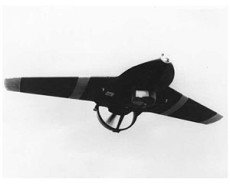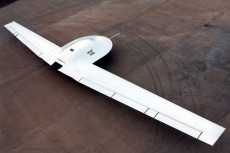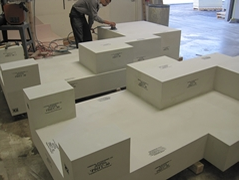Part 1 of 2
 It’s not everyday one gets to speak to air racing legend Jon Sharp. He’s so respected and well known in the air racing community that one of his planes is even housed in the Smithsonian next to the Space Shuttle Discovery and Enola Gay. Needless to say, I jumped at the chance to interview him. Jon also owns Nemesis Air Racing and is a former Lockheed Martin Skunk Works Composites Engineer. While talking to me probably wasn’t as exciting as racing a plane across the finish line or putting the final touches on a top-secret government project, Jon was nice enough to give me a glimpse into these fascinating industries and his role in the rise of high density polyurethane as a tooling substrate.
It’s not everyday one gets to speak to air racing legend Jon Sharp. He’s so respected and well known in the air racing community that one of his planes is even housed in the Smithsonian next to the Space Shuttle Discovery and Enola Gay. Needless to say, I jumped at the chance to interview him. Jon also owns Nemesis Air Racing and is a former Lockheed Martin Skunk Works Composites Engineer. While talking to me probably wasn’t as exciting as racing a plane across the finish line or putting the final touches on a top-secret government project, Jon was nice enough to give me a glimpse into these fascinating industries and his role in the rise of high density polyurethane as a tooling substrate.
When he was a kid, Jon raced tricycles, go karts, model cars, motorcycles – just about anything with wheels. His love for racing continued into his later years, and before long he started looking for a low-cost airplane he could purchase. In 1978 he purchased a race plane from a friend, which made him the proud owner of a Cassutt Special.
Jon was eventually approached by legendary air racing pilot Bob Downey, who taught him the finer points of air racing prior to his first race in Mexicali, Mexico. (Jon’s racing career is examined in detail in part 2 of this story) His love for planes, combined with his work making composite parts on projects such as the Applebay Sailplane’s Zuni glider, and the Miller JM-2 race plane familiarized him with composite tooling methods. This experience proved to be a priceless asset in landing a future position at Lockheed Martin.
 His hiring at Lockheed’s Austin, Texas location in 1983 made him the 500th employee at a location that would later employ up to 5,000. One of the first projects he worked on was the Lockheed MQM -105 “Aquila” kevlar composite UAV. He participated as right-seat pilot and flight engineer of a DeHavilland Otter, carrying the Aquila in a captive-carry position during simulated missions to verify the UAV’s communication and system links (sounds kind of like a pilot’s dream job if you ask me!).
His hiring at Lockheed’s Austin, Texas location in 1983 made him the 500th employee at a location that would later employ up to 5,000. One of the first projects he worked on was the Lockheed MQM -105 “Aquila” kevlar composite UAV. He participated as right-seat pilot and flight engineer of a DeHavilland Otter, carrying the Aquila in a captive-carry position during simulated missions to verify the UAV’s communication and system links (sounds kind of like a pilot’s dream job if you ask me!).
In 1989, Jon and his wife Patricia moved to Burbank, CA, in order to be closer to Jon’s new position at Lockheed Martin Skunk Works, which is a group within Lockheed Martin that works on highly secretive projects. Credits to Skunk Works include the infamous SR-71 Blackbird and F-117 Nighthawk.
 While many of the projects Jon was involved in are still classified, he was heavily involved in the now-declassified Lockheed Martin/Boeing RQ-3 Darkstar UAV program. An early precursor to modern day UAV’s, Darkstar was designed as a high-altitude endurance UAV with stealth technology. This project, with Jon’s leadership and dedicated team, was the first time high density polyurethane was used for tooling on a government contract job, a pioneering move for the tooling world of the early 1990’s. It helped to pave the way for the large amount of HDU seen today in the aerospace and composites industries.
While many of the projects Jon was involved in are still classified, he was heavily involved in the now-declassified Lockheed Martin/Boeing RQ-3 Darkstar UAV program. An early precursor to modern day UAV’s, Darkstar was designed as a high-altitude endurance UAV with stealth technology. This project, with Jon’s leadership and dedicated team, was the first time high density polyurethane was used for tooling on a government contract job, a pioneering move for the tooling world of the early 1990’s. It helped to pave the way for the large amount of HDU seen today in the aerospace and composites industries.
 Jon shared his thoughts on what it meant to switch from the time-consuming tooling methods they were accustomed to, to high density urethane:
Jon shared his thoughts on what it meant to switch from the time-consuming tooling methods they were accustomed to, to high density urethane:
“90% of the tooling for Darkstar was made from 10lb and 20lb. HDU. It would have cost us roughly 30 times that amount to do the tooling with metal. Not only that, as soon as we discovered the numerous options we had for block configuration and sheet size, we never went back to bonding up railroad-tie size pieces of wood or buying chunks of metal like we did in the past,” he said.
Customization options, allowing for easier accommodation of design changes, also played a large role in high density polyurethane winning the hearts and minds of the aerospace tooling industry. He went on to say,
“Another major reason we were so drawn to HDU for tooling was the greater level of design flexibility that was suddenly available. We used to order our blocks several inches thicker than we needed them, which made the inevitable design changes much less of a headache. Could we have done that with metal? Absolutely not, we would have had to start all over again.” says Sharp. “The bottom line is, once high density urethane became available, we weren’t about to spend millions of dollars on tooling for a prototype, especially one that could be of limited life! The quality, consistency, and block configuration options of Precision Board cut labor time and cost down so drastically that we didn’t want to use anything else!”
Jon’s career at Lockheed Martin spanned an impressive 25 years, in departments ranging from the propulsion laboratory to advanced composites. He watched many of the most well-known aerospace projects of today use high density polyurethane as the soft tooling for prototype components. These include early F-35 and F-22 prototypes, along with the Boeing 737 ARTB (Advanced Radar Test Bed).
Part 2 of this story, which covers Jon’s air racing career with his competition-winning planes – one of which is housed in the Smithsonian next to the Space Shuttle Discovery and the Enola Gay can be seen here. Subscribe to our blog by Liking us on Facebook or Following us on Twitter!
In the meantime, you can also check out Jon’s website, www.nemesisnxt.com, for more information and pictures.
See Precision Board in action on a CNC machine with this video of PBHT-60 on the router at ADM Works: